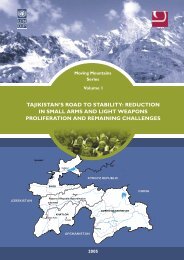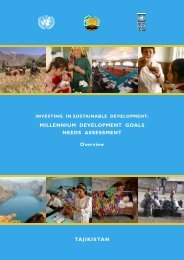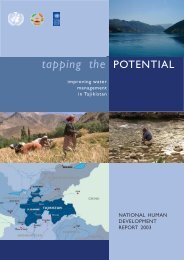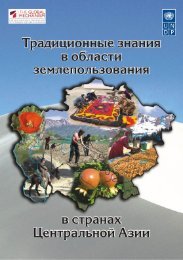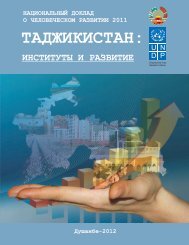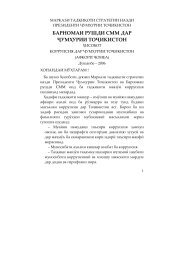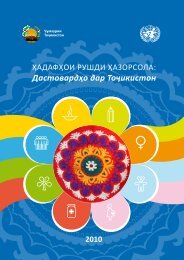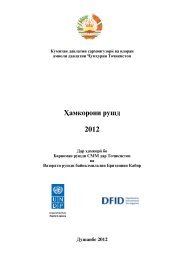Eng - UNDP in Tajikistan
Eng - UNDP in Tajikistan
Eng - UNDP in Tajikistan
You also want an ePaper? Increase the reach of your titles
YUMPU automatically turns print PDFs into web optimized ePapers that Google loves.
DEVELOPMENT PARTNER PROFILE<br />
NGO<br />
The Branch of Save the Children Federation/US <strong>in</strong> Republic of<br />
<strong>Tajikistan</strong><br />
Contact: Mr. Benjam<strong>in</strong> Phillips<br />
Director of the Branch of Save the Children Federation <strong>in</strong><br />
Republic of <strong>Tajikistan</strong><br />
Tel: 224-33-88, 221-07-71 Fax: 251-00-79<br />
E-mail: scfcafo@savechildren.tj<br />
Website:<br />
Organization Profile<br />
The Branch of Save the Children Federation (USA) <strong>in</strong> Republic of <strong>Tajikistan</strong> is a voluntary, non-governmental, non-religious, non-profit<br />
organization work<strong>in</strong>g <strong>in</strong> accordance to the Charter, Constitution of Republic of <strong>Tajikistan</strong> and the law of <strong>Tajikistan</strong> about “Social<br />
Organizations”, current legislation of <strong>Tajikistan</strong> and other <strong>in</strong>ternational legal acts, acknowledged by Republic of <strong>Tajikistan</strong>. The goals and<br />
objectives of the Branch are: assistance <strong>in</strong> common social welfare of the society, render<strong>in</strong>g assistance, alleviation of suffer<strong>in</strong>g and<br />
improvement of life of people of <strong>Tajikistan</strong>, particularly children through implementation of charitable, educational and developmental<br />
activities. Goals and objectives of the branch also <strong>in</strong>clude provision of welfare of children without division of the nationality basis,<br />
improvement of the status of children and everyth<strong>in</strong>g that may concern children’s welfare <strong>in</strong>clud<strong>in</strong>g (without harm<strong>in</strong>g the majority) grant<strong>in</strong>g<br />
and support<strong>in</strong>g children’s education, their appropriate feed<strong>in</strong>g, hygiene and health care, for improvement of their liv<strong>in</strong>g conditions, clean<br />
water and sanitation provision <strong>in</strong> family and society (<strong>in</strong> any context), for ensur<strong>in</strong>g children’s welfare <strong>in</strong> family and society (<strong>in</strong> any context),<br />
for their legal protection and representation of their <strong>in</strong>terests and for ensur<strong>in</strong>g their security.<br />
Past and Current Programmes<br />
Save the Children <strong>in</strong> <strong>Tajikistan</strong> works <strong>in</strong> five major sectors. These are health, education, child protection and food security. The organization<br />
has ma<strong>in</strong> office located <strong>in</strong> Dushanbe and Impact Area Offices located <strong>in</strong> Kulyab, Kurgan Tube and Khujand. DAP(Development Assistance<br />
Program) Program is implement<strong>in</strong>g <strong>in</strong> Khatlon Region, Girls Education Program implement<strong>in</strong>g both <strong>in</strong> Khatlon and Sugd, Child Protection<br />
Program implement<strong>in</strong>g ma<strong>in</strong>ly <strong>in</strong> Dushanbe as well as PHASE Program implement<strong>in</strong>g <strong>in</strong> Khatlon.<br />
Under DAP Program Save the Children provides food commodities to pre-school and primary school children <strong>in</strong>stitutions throughout the poor<br />
Khatlon region. The <strong>in</strong>ception of this program led to an <strong>in</strong>crease <strong>in</strong> average school attendance. The aim of this program is to improve food<br />
security situation of a vulnerable families and communites. Activities of this program are also focused on an improvement of health and<br />
nutrition of schoolchildren, improvement of school <strong>in</strong>frastructure, promot<strong>in</strong>g and conduction of Child to Child sections, improvement of<br />
children knowledge.<br />
The aim of PHASE (Personal Hygen and Sanitary Education) Program <strong>in</strong> <strong>Tajikistan</strong> is to improve children's health and wellbe<strong>in</strong>g so that they<br />
can learn and participate better <strong>in</strong> schools and become healthier adults and parents <strong>in</strong> future. The program not only focuses on improv<strong>in</strong>g<br />
children's knowledge, but also on b<strong>in</strong>d<strong>in</strong>g their skills and creat<strong>in</strong>g social and physical environments which protect them from the risk of poor<br />
sanitation and dirty water. Child to Child approach of behavior change is the ma<strong>in</strong> at every stage of the program. Many teachers are ta<strong>in</strong>ed on<br />
CTC approach. Twenty latr<strong>in</strong>es and 42 handwash<strong>in</strong>g stands were constructed and distributed to schools and are currently used by children.<br />
Girls Education Program has the goal to improve girls access to quality education <strong>in</strong> <strong>Tajikistan</strong>. The specific objectives of program is to<br />
improve the base of <strong>in</strong>formation on the situation of children, especially girls; improve participation of community, parents and school<br />
authorities <strong>in</strong> plann<strong>in</strong>g , management and monitor<strong>in</strong>g of schools; strengthen<strong>in</strong>g <strong>in</strong>clusive and child friendly environment and to advocate for<br />
changes <strong>in</strong> policies, reforms and practicies on quality and <strong>in</strong>clusive education accessible for all children, especially girls. Totally 50 schools<br />
were chosen as a result of base-l<strong>in</strong>e study conducted by M<strong>in</strong>istry of Education and UNICEF. The direct beneficiaries are 1200 girls between<br />
15-18 years old who dropped out of school and the <strong>in</strong>tended result of the project is to br<strong>in</strong>g back these 1200 girls and prevent drop out of<br />
those girls who are at risk.<br />
The aim of Child Protection Program is to establish community based, susta<strong>in</strong>able, child protection systems and mechanisms to protect the<br />
rights of children, primarily children work<strong>in</strong>g <strong>in</strong> streets for wages, through develop<strong>in</strong>g the capacities of relevant key stakeholders and <strong>in</strong>crease<br />
the level of awareness, accountability and support of key duty bearers (e.g. civil societies, communities, key <strong>in</strong>fluential people, donors etc) for<br />
children’s rights agenda. This program has two components: Child Labour and Juvenile Justice. Child Labour Project is implement<strong>in</strong>g <strong>in</strong><br />
collaboration with M<strong>in</strong>istry of Labour and Social Protection and Social Organizations. 286 street work<strong>in</strong>g children were covered by this<br />
project us<strong>in</strong>g different approaches. Project of Juvenile Justice is implement<strong>in</strong>g <strong>in</strong> a close collaboration with m<strong>in</strong>istry of Internal Affaires. 70<br />
<strong>in</strong>spectors on m<strong>in</strong>or's were tra<strong>in</strong>ed on <strong>in</strong>ternational justice standards also tra<strong>in</strong><strong>in</strong>gs were conducted to 500 school students to prevent juvenile<br />
crim<strong>in</strong>ality.<br />
For more than five years Save the Children has implemented a Child Survival project <strong>in</strong> the remote Zeravshen Valley, which is cut off from<br />
the Capital Dushanbe by snowbound passes for six months of the year. This project tra<strong>in</strong>ed midwives and other health workers <strong>in</strong> improved<br />
approaches to ante-natal, delivery and post-natal care, <strong>in</strong>fant and child nutrition and prevention and treatment of basic diseases of childhood.<br />
This particular program was successfully completed at the end of September 2007 <strong>in</strong> Penjikent and A<strong>in</strong>i Districts.<br />
Save the Children was implement<strong>in</strong>g similar activities <strong>in</strong> ten districts <strong>in</strong> Khatlon region under MCH/RH program. This program ended at the<br />
end of February 2008.<br />
Source: Aid Coord<strong>in</strong>ation and Project Monitor<strong>in</strong>g System Database<br />
© State Committee on Investments and State Property Management of the RT<br />
100




